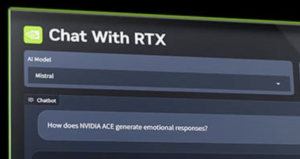 Recent efforts by Nvidia and Apple in deploying large language models (LLMs) locally on devices mark an interesting development in the evolution of generative AI technology. Both companies, leaders in their respective fields, are pioneering efforts to harness the power of LLMs directly on users’ devices, bypassing the conventional cloud-based model. This shift towards local processing of LLMs is poised to revolutionize user interaction with AI by offering distinct advantages.
Recent efforts by Nvidia and Apple in deploying large language models (LLMs) locally on devices mark an interesting development in the evolution of generative AI technology. Both companies, leaders in their respective fields, are pioneering efforts to harness the power of LLMs directly on users’ devices, bypassing the conventional cloud-based model. This shift towards local processing of LLMs is poised to revolutionize user interaction with AI by offering distinct advantages.
Two recent events sparked this discussion:
- Nvidia announced the demo version of their “Chat with RTX”: raising both awareness and expectation for robust, speedy conversational access and control over information that resides in the memory of a personal computer.
- Apple researchers have published a paper describing how to run an LLM in Flash Memory: paving the way for LLMs to reside and work their magic on devices like smart phones. More detail on the paper can be read here, a post that also mentions that “this is only Apple researchers figuring out a way to run LLMs locally using flash memory, and not a confirmation of Apple actually releasing an app or embedding AI in its coming updates.”
The momentum toward local deployment coincides with the proliferation of open source large language models (LLMs), such as the Mistral models and Meta’s Llama. Together, they significantly impact the landscape of AI development and deployment. Open source models provide a foundation for companies and developers to experiment with and visualize new applications for LLMs, including the ability to run smaller, more efficient versions on devices, rather than in the cloud. The trend towards open source lowers barriers to entry, allowing for broader experimentation and innovation in the field.
Let’s catalog the advantages of solution architectures that embrace on-device LLMs:
Privacy Enhancements
One of the most compelling benefits of running LLMs locally is the substantial increase in data privacy. Unlike cloud-based models where data is transmitted over the internet for processing, local inference ensures that all user interactions remain on the device. This approach eliminates the risk of sensitive data being used for training purposes by third parties or accessed by unauthorized individuals, providing a secure environment for users to interact with AI technologies.
Improved Response Times
Local processing of LLMs also translates into faster response times. By eliminating the need to send data to and from the cloud, latency is significantly reduced, offering users near-instantaneous interactions with AI applications. This improvement in speed enhances the user experience, making AI technologies more seamless and integrated into daily tasks.
Cost Savings
Lastly, running LLMs locally can lead to substantial cost savings for users. Cloud-based AI services often come with API fees, which can accumulate with extensive use. Local processing eliminates these costs, making powerful AI tools more accessible to a broader audience without the burden of recurring charges.
Looking Under the Hood
Nvidia’s “Chat with RTX” and Apple’s method for running LLMs using flash memory on devices with limited RAM are prime examples of how the tech industry is adapting to meet the demand for more private, efficient, and cost-effective AI solutions. Nvidia’s approach leverages the power of RTX GPUs to enable sophisticated chatbots that run directly on users’ PCs, while Apple’s research showcases the potential for iPhones to perform complex AI tasks without relying on cloud computing. Both initiatives underscore the tech industry’s commitment to innovation, pushing the boundaries of what’s possible with AI while prioritizing user privacy, efficiency, and affordability.
Implications for the Enterprise
These developments signal a promising future where enterprise employees can leverage the full potential of generative AI directly on their personal devices, addressing many of the concerns of data privacy that make companies wary of using LLMs. As Nvidia, Apple, and others continue to refine their technologies, we can expect to see a wider adoption of locally run LLMs, setting a new standard for privacy, performance, and cost-effectiveness in the AI landscape.
Categories: Intelligent Assistants

 2025 Conversational AI Intelliview: Decision-Makers Guide to Self-Service & Enterprise Intelligent Assistants
2025 Conversational AI Intelliview: Decision-Makers Guide to Self-Service & Enterprise Intelligent Assistants  Talk to the Web: How NLWeb Opens Conversational Access to Site Content
Talk to the Web: How NLWeb Opens Conversational Access to Site Content  Battling ‘Botenfreude’: The Power of People and Policy
Battling ‘Botenfreude’: The Power of People and Policy  Voice AI Agents Redefine CX: Trends, ROI, and Strategies for 2025
Voice AI Agents Redefine CX: Trends, ROI, and Strategies for 2025